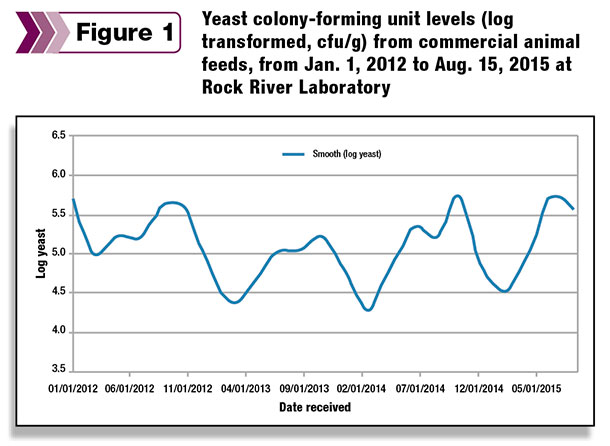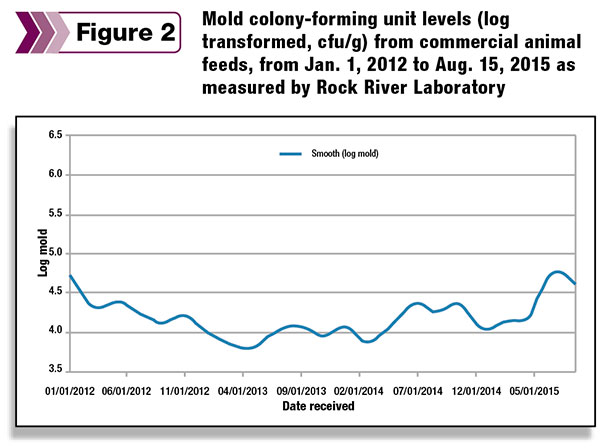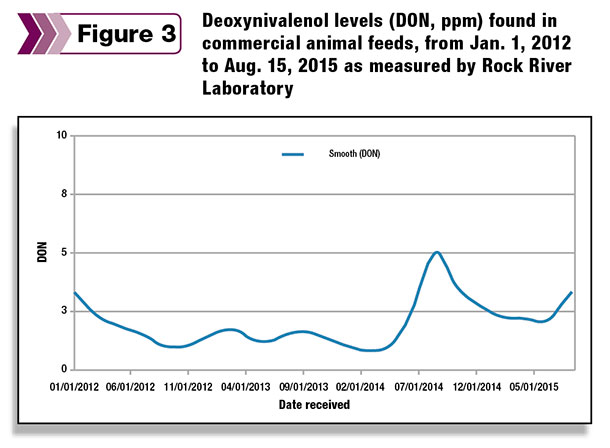This subject may sound ludicrous, yet there is a real and present meaning to the attention-grabbing phrase. The term “anti-nutrition” has been used periodically within animal nutrition conversation but more recently in on-farm support calls and while troubleshooting with consultants to discuss nutrition measures that relate to challenges in animal health and performance.
We generally understand there are some facets of dairy feed that yield trouble, but what do they really do in the animal? Nutrition laboratory measures such as mold counts (colony-forming units, cfu per g of forage) could really be classified as “anti-nutritional.”
By this, I mean that these living organisms or other negative feed characteristics can rob the animal of nutrition. There are two general anti-nutrition pathways I consider when troubleshooting with consultants, leading to health and performance challenges:
-
Pathway 1: Soil and feed-borne microbes break down and deprive the TMR of nutrient content prior to dairy cattle consumption.
- Pathway 2: Negative microbes or compounds affect the animal such that the cow cannot obtain nutrition from the TMR or eats less of the TMR.
Generally speaking, there are several types of anti-nutritional, microbiological and mycotoxin evaluations. Admittedly, our industry has a lot to learn. For example, we can quantify a couple dozen mycotoxin compounds routinely, but German chemists have shown us thousands exist.
In addition, our understanding of how mycotoxins react within the animal’s body may be limited. Let’s review the general anti-nutrition measures we can dig into if you suspect your cattle are being robbed of nutrition.
Beginning in the soil and then moving into the field, yeast organisms can kick-start a negative spiral that both breaks down nutrients prior to feeding and negatively affects rumen metabolism. This function can occur in poorly preserved or poorly stabilized silages and even in some commodity feeds.
In the silage, yeast function in anti-nutrition pathway 1 by metabolizing sugars and other readily digestible carbohydrates as well as lactic acid.
Losing lactic acid then leads to the forage pH rising, which gives way to mold growth and possibly mycotoxin production. Further, research has shown us how wild (epiphytic) spoilage yeast act through anti-nutrition pathway 2 by altering rumen metabolism, negatively affecting nutrient digestion.
The bottom line? Based on guidelines we wrote after assessing Rock River Laboratory’s database, as well as consulting with professor Lon Whitlow of North Carolina State University, the goal for yeast counts should be less than 200,000 cfu per g, keeping in mind that if you feed beneficial yeast in your TMR, laboratory measures will quantify that as well.
In Figure 1, yeast count trends over time are displayed, dating back to January 2012. Notice that yeast levels for feeds representing California to Wisconsin to New York are among the highest levels we’ve seen over the past few years, likely due to challenges in growing and harvesting seasons during the prior crop year.
 Mold (fungal) species are similar to yeast organisms in that they are born in the field, on the crop, and then further grow in silages or other feeds if given the chance.
Mold (fungal) species are similar to yeast organisms in that they are born in the field, on the crop, and then further grow in silages or other feeds if given the chance.
Mold contamination and identification has become an increasingly curious area, with many consultants further evaluating not only mold levels but also seeking to identify the species present. It’s important to keep in mind there are thousands of known molds, and we identify a mere fraction.
Mold functions as an anti-nutritional factor as the mold colonies rob the feed of nutrition. Similar to yeast colony counts, in Figure 2 you’ll notice that mold cfu levels have increased substantially during the 2015 summer. The bottom line? Again based on the guidelines referenced earlier, aim for less than 2,000 cfu per g of mold within feeds.
 Despite the increase in mold colony frequency within feed, the fungal organisms are not acting directly through anti-nutrition pathway 2. The culprit challenging animal health and ability to metabolize nutrients lies with the mycotoxic compounds mold species produce. Mycotoxins can have several effects within an animal; some documented effects include:
Despite the increase in mold colony frequency within feed, the fungal organisms are not acting directly through anti-nutrition pathway 2. The culprit challenging animal health and ability to metabolize nutrients lies with the mycotoxic compounds mold species produce. Mycotoxins can have several effects within an animal; some documented effects include:
- Irritating gut tissue, contributing to greater porosity and weakening the tight junctions’ and tissue’s ability to fight bacterial infection
- Suppressing the immune system
- Mimicking estrogen and negatively affecting reproductive processes
Unfortunately, we do not understand why and when mold colonies produce these toxic compounds; hence, we must measure them directly to assess feeds’ anti-nutritional capacity.
There are thousands of known toxins, yet we can identify only a handful. All is not lost though, as professor Whitlow helped me understand that we can use Vomitoxin (or deoxynivalenol, DON) as a marker for general toxin contamination.
Further, in cases where one toxin is present, there are likely several others possibly leading to a negative synergistic effect on animal health and the animal’s ability to utilize nutrients. In Figure 3, we can see Vomitoxin (DON) levels within animal feedstuffs over the past two years.
 Wheat, small grain and straw harvest in mid-2014 brought substantial toxin contamination from the field, yet later-harvested crops continued to exhibit moderate DON levels and are following an increasing trend again in mid-2015. For dairy cattle, aim for less than 1.0 parts per million DON within the TMR to avoid anti-nutrition implications.
Wheat, small grain and straw harvest in mid-2014 brought substantial toxin contamination from the field, yet later-harvested crops continued to exhibit moderate DON levels and are following an increasing trend again in mid-2015. For dairy cattle, aim for less than 1.0 parts per million DON within the TMR to avoid anti-nutrition implications.
To be transparent, the data and graphs discussed here may not be a true representation of field conditions. For example, samples and data included in the graphs likely have been from suspicious feeds, hence the testing for anti-nutritional compounds. Yet the trends over time are likely valid to consider relative changes from year to year.
If you suspect your TMR is being raided of nutrition through one of the avenues discussed here, work with advice from your consulting team in assessing anti-nutrition potential.
Start by quantifying the TMR’s mold and yeast colony counts, then if microbial measures are excessive or animal health is severely compromised, continue with DON or extensive toxin analyses as needed. Finally, work backwards to individual feeds as warranted.
If anti-nutrition factors are present, work to minimize mold and yeast growth in the field, at the silo and in the feedbunk, using research-proven management practices or products. There are a number of options available to suppress and manage negative microbial growth.
Also consider toxin management strategies, such as diluting the contaminated feed to reduce the TMR level or including a research proven toxin binder.
Anti-nutritional factors can exist in many feedstuffs, but by being cognizant of how they work, what they produce aesthetically and how to manage their numbers and types, we can work to keep our feed and our animals safe and performing at optimal efficiency – utilizing the ration and its nutrients to full capacity. PD
John Goeser earned a Ph.D. in animal nutrition from University of Wisconsin – Madison where he currently serves as an adjunct professor in the dairy science department. He also directs animal nutrition, research and innovation efforts at Rock River Lab Inc., based in Watertown, Wisconsin.
References omitted due to space but are available upon request. Click here to email an editor.

-
John Goeser
- Director of Nutrition, Research and Innovation
- Rock River Laboratory Inc.
- Email John Goeser






